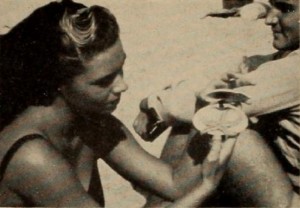
"By a facile blending of warm hearted humor and a keen perception of human interest values, George Mesaros has created a film study of a famous beach in New York's metropolitan area that is replete with interest, information and entertainment. His technical skill and knowledge of what makes a motion picture move prevent this from being the dull collection of random shots all too frequently characteristic of this genre subject. Employing himself as a frenzied and frustrated shutterbug and a filming friend as plain Joe Doakes at the beach with his wife, a lunch and box camera, Mr. Mesaros proceeds to examine with interest and obvious affection the thousand and one attractions of the Long Island resort. An excellent musical score and a brief commentary help to integrate the compact 700 feet of the film's lively length." Movie Makers, Dec. 1949, 454.
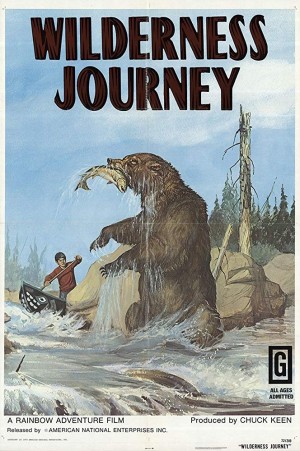
"Joniko and the Kush-Ta-Ka, the PSA Film of the Year, is a story of Alaska by a native, Charles Keen of Juneau. In 45 minutes of color and spectaculars, Mr. Keen shows us an Alaska that is beautiful throughout the seasons of the year. The law of nature is never questioned and only strength and courage survive. As if all this as not enough in the way of survival difficulties, there is added the threat of the Kush-Ta-Ka. You struggle, struggle some more and pray with young Joniko in his adventuresome trip to get help. It is truly a film of the year" PSA Journal, Nov. 1969, 56.
"A diesel followed by yesterday's steam locomotives lay the contrasts for this journey to yesterday. Rio Grande's old seam locomotive 473 takes us from Durango to Silverton, Colorado, through the wild country where enroute we see things today as they were yesterday. Throughout this trip we feel the realism of the sound accompaniment, so tastefully a part of the picture. The maker of this film was well aware of the need to include people and human interest, and it did it well" PSA Journal, Nov. 1959, 48-49.
"Joyous Noel by Gilbert B. Jansen Jr. is the sort of color motion picture record of an American family's Christmas that so many home-loving cameramen dream of producing - but seldom do. Undoubtedly the producer and all members of his family will treasure this film immediately. Not a great work, Joyous Noel is nevertheless an unusually good Christmas film in which all of the preparations and celebrations found in graceful family living are depicted through the activities of a young couple and their two children. Well lighted scenes, technically proficient camera work, pleasant acting by all concerned, and a background of Christmas carol music all contribute to make this a thoroughly pleasant production" PSA Journal, Jan. 1955, 50.
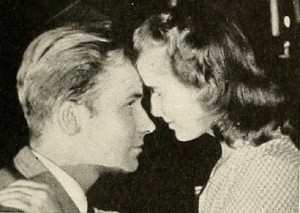
"Lake Mohawk, Preferred, made by Leo J. Heffernan, is a picture of the attractions, residences, entertainments, dog shows, yachting regattas and water sports of Lake Mohawk in New Jersey. But Lake Mohawk, Preferred is also a film with a continuity idea utterly new to amateur movies, for the not unusual subject matter of the picture is held together with a "screwball" theme and "gags" that keep you wondering what is going to happen next and entertained in the meantime. A handsome couple have a movie camera. "Concentrate to make good movies," says their instruction book. This they do in a very pleasant way (see the frame enlargement on page 577), and the results are surprising. Their mental efforts transport them and the camera bodily about the lake, at just the right time and place to film whatever is going on. They have some astonishing experiences, too. Sometimes they can't seem to materialize, and they pick up odd characters in their voyages through ether. But their method works and they get beautiful and lively sequences of life at Lake Mohawk." Movie Maker, Dec. 1940, 603.
"Oscar Horowitz, of Newton, Mass., has taken the theme of Plymouth and developed it into the Movie of the Month. Opening with scenes of modern Plymouth we are reminded of the growth and prosperity that is our heritage. And this month, November, as the nation prepares to again celebrate Thanksgiving, Home Movies Magazine salutes Mr. Horovitz for producing a film that should remind one and all of the unrestricted freedom and opportunities that exist within our borders." Home Movies, Nov. 1950, 460.
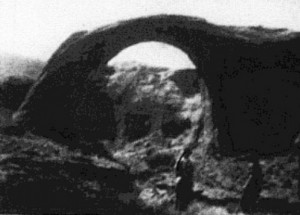
"After years of seeing the rugged Colorado River conquered by small parties of adventurers as rugged as the river itself, O.L. Tapp has produced Land of the Rock Up Over, a film in which a party of perhaps half a hundred young men and women thoroughly enjoy a mass invasion of the river country in seven large rubber rafts and only one cataract boat. The charm of Mr. Tapp's capable but perhaps over-long film lies in the companionship, fun, and excitement that stem from the very size of the exploring party. Admittedly in the river passage from Hite, Utah, to Lee's Ferry the river's most dangerous rapids have been avoided. But who cares - the group had fun! Skillfully photographed and with an interesting narrative well-recorded on magnetic stripe, the film holds audience attention by its very competence throughout its considerable length" PSA Journal, Jan. 1955, 50.
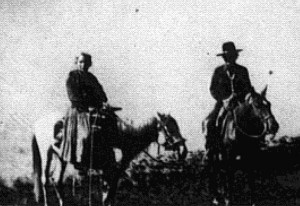
"The wilderness of Colorado where the visitor may wonder how the Indian can extract a livelihood from the dry, treeless land. To be sure, there are trees, and some with the raiment of ghosts, from which life long ago departed. The rugged Indian does eke a living from this waste, mostly from sheep, goats, weaving, and trinkets. The film is a record of these things in well chosen settings, including a desert storm" PSA Journal, Oct. 1961, 49
"A well done travelogue of Hawaii showing the sports the tourist usually sees, the profusion of flowers, etc." PSA Journal, Nov. 1956, 45.
A Little Bit of Yukon takes you on a trip north to Alaska. You get 18 minutes of some very beautiful scenery (in color, of course) and the location of some very well-stocked fishing holes. Tom Mitoma is our tour guide, with a very good job of camera work. It's an interesting film for outdoorsmen and a very easy way to take a trip to Alaska for those of us who are not," PSA Journal, Mar. 1970, 44.
Total Pages: 23